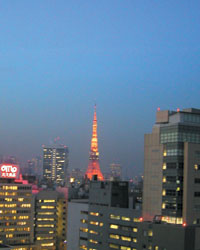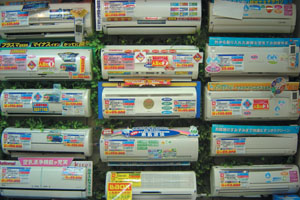Tepco's Blackout Bluster
Back to Contents of Issue: July 2003
|
|
|
|
by Leo Lewis |
|
 LIKE THE GREAT WALL of China and the Grand Canyon, the sprawling city of Tokyo by night is one of those phenomena clearly visible from the moon. As you gaze across the surface of the globe, Japan's capital shines, literally, like a beacon -- the biggest concentration of electric lights anywhere in the world. LIKE THE GREAT WALL of China and the Grand Canyon, the sprawling city of Tokyo by night is one of those phenomena clearly visible from the moon. As you gaze across the surface of the globe, Japan's capital shines, literally, like a beacon -- the biggest concentration of electric lights anywhere in the world.
But any astronaut who happens to look out of the window at the wrong time this summer may be in for a bit of a surprise. If the weather gets too hot, and the air conditioners pump too hard, the world's biggest city could black out completely.
The spectre of a place like Tokyo without electricity and plunged into total darkness, even for just a quarter of an hour, is nightmarish. Apart from the physical threats of car accidents, packed underground trains grinding to a halt and general stampeding panic, the economic impact would be vast. From backstreet izakaya to Ginza's flashiest depaato, a Tokyo dark and without power is a Tokyo of red ink.
But such a blackout -- or series of blackouts -- is not the vision of raving doomsayers. Unfortunately, the stark warnings come from the very company that generates the juice in the first place. The Tokyo Electric Power Company (Tepco) has now made it explicit: If the mercury rises too high this summer, and Tokyo uses too much power trying to cool itself down, the lights could go out.
Tepco has not made a mystery about why this threat is now looming over Tokyo. In the course of the 90s, small cracks emerged at some of its atomic power stations. These problems were then covered up, and their exposure at the end of the decade quickly flung the company into the middle of a damaging scandal. For historical reasons, Japan is a country where the public has maintained a hyper-sensitivity when it comes to all things atomic. In Fukushima and Niigata -- prefectures with two of the offending stations -- the public outcry against Tepco has been particularly fierce.
A Tokyo without power Under intense pressure, Tepco earlier this year announced that it would be closing all 17 of its reactors to run safety checks. One has since been switched back on, but 16 remain inoperative. This, says Tepco, is why Tokyo could face power problems over the long, hot summer.
Tepco's warnings have come in several forms, each of which provide deeper insights into the managerial chaos that many analysts believe is behind Tepco's current woes. At the start of the year the company introduced, via TV, a power conservation campaign. This was gradually stepped up to the point where the company is now telling office workers to switch the lights and computers off when they head out to lunch. In a comment made on its Web site, alluding to the possibility of power shortages, the company surreptitiously admitted that the whole issue boiled down to its mishandling of the recent reactor scandals.
The problem is that Tepco's self-interest in the blackout warnings is patently obvious. In mid-May the company published full-year results and said that group profits and revenues shrank in fiscal 2002 for the first time in four years. Net profit for the year ending March 31 fell more than 18 percent from the previous year because the company has had to shoulder increased fuel costs. With its nuclear reactors shut down, Tepco has been forced to rely on its traditional generators, which use commodities like oil and gas whose prices have been soaring.
It is in Tepco's pressing commercial interest to turn its reactors back on, but to perform the necessary checks could take until late September, says an energy expert spokesman for Green Action. It's a tricky situation. On one side is the threat of reigniting nuclear power stations that may be unsafe; on the other is the sticky misery of Tokyo without lights and air conditioners.
Further evidence comes from revelations about Tepco's various appeals for backup supply from generating companies in surrounding areas. In March, Tepco asked for a combined 300,000 kilowatts of power from Kyushu Electric, Kansai Electric and Chugoku Electric. That request, in itself, was taken as a significant sign that Tepco knew more about the threat than it was letting on. When, in late May, Tepco doubled its request to 600,000kw, the alarm bells began to sound.
Tepco's self-interest in the blackout The third piece of evidence -- and probably the most compelling -- comes from corporate Japan, and specifically those companies who have factories or other plants in the area covered by Tepco's generators. Everyone would suffer, but manufacturers have potentially the most to lose from a break in the power supply, and many companies say that it is simply too late to start thinking of building emergency generators.
Among those companies who have demanded talks with Tepco, or have undertaken plans to move production into other parts of Japan, are Daido Steel, Kawasaki Steel and Kirin, the beer behemoth. Kirin has breweries across the country, but around 40 percent of its output comes from factories in the Tepco area. The consumer electronics giant Sony has also been in discussions with Tepco about the blackout threat, since four of its production facilities -- the ones that churn out PlayStation2 and CD Walkmans -- would go dark.
But there are arguments that suggest Tepco is inflating the problem precisely so that it can exert the political pressure it needs to switch its power stations back on. One of those arguments comes from the Japan-based Citizens' Nuclear Information Center. A spokesman told J@pan Inc that even a few basic conservation techniques, such as staggering air conditioner use or giving price breaks to companies using power at off-peak times, would reduce the blackout risk considerably.
But the strongest argument against Tepco comes from the central government. A blackout in Tokyo would certainly cost the city billions of yen in lost production and potential damage. But in all the coverage of this issue, a precise estimate has never been used. Why? Because no official agency has bothered to do the sums. Not the office of the governor of Tokyo, nor the Ministry of Finance, nor the Ministry for the Economy, Trade and Industry nor even the cabinet office. Either they are all sleeping on the job, say the analysts, or they know that they do not really need to worry.
In the meantime, however, the suits in Kasumigaseki have at least shown some effort. The air conditioners in certain public buildings will be set one degree warmer than normal this summer as a gesture of concern. Other measures include dousing the lights for two hours on Tokyo tower and other major landmarks during the summer solstice.
Perhaps the passing astronaut will have something to look at through the window after all. @
May 1951
November 1953
August 1969
March 1971
January 1991
July 1997
March 2000
March 2000
July 2001
December 2002
March 2003
April 2003
|
|
Note: The function "email this page" is currently not supported for this page.


 A number of factors lead one to assume that the blackout threat is very real. The TV campaign is costing Tepco a lot of money, and even though the theme of power conservation has won the support of environmental lobby groups, everyone is clear why it is really being run. If Tokyo does black out, the blame will be laid only at one door, and heads at the top of Tepco will roll. The catastrophe -- complete with dramatic images of Shibuya's neon flickering out -- would certainly attract international attention and exacerbate the embarrassment. The TV campaign therefore serves two purposes: One is the chance that people might respond well and avert the crisis anyway. The other is that Tepco will always be able to shift some of the blame onto those Tokyoites -- both individual and corporate -- who ignored the calls to cut back on power consumption before it was too late.
A number of factors lead one to assume that the blackout threat is very real. The TV campaign is costing Tepco a lot of money, and even though the theme of power conservation has won the support of environmental lobby groups, everyone is clear why it is really being run. If Tokyo does black out, the blame will be laid only at one door, and heads at the top of Tepco will roll. The catastrophe -- complete with dramatic images of Shibuya's neon flickering out -- would certainly attract international attention and exacerbate the embarrassment. The TV campaign therefore serves two purposes: One is the chance that people might respond well and avert the crisis anyway. The other is that Tepco will always be able to shift some of the blame onto those Tokyoites -- both individual and corporate -- who ignored the calls to cut back on power consumption before it was too late.



